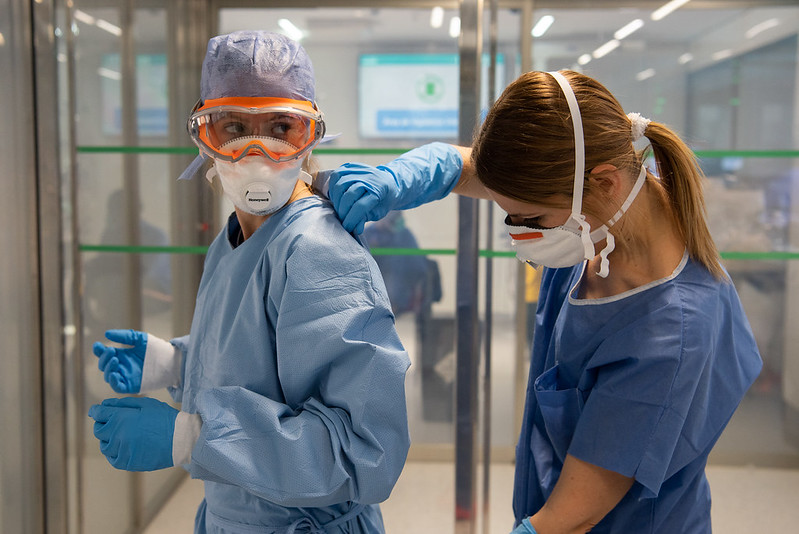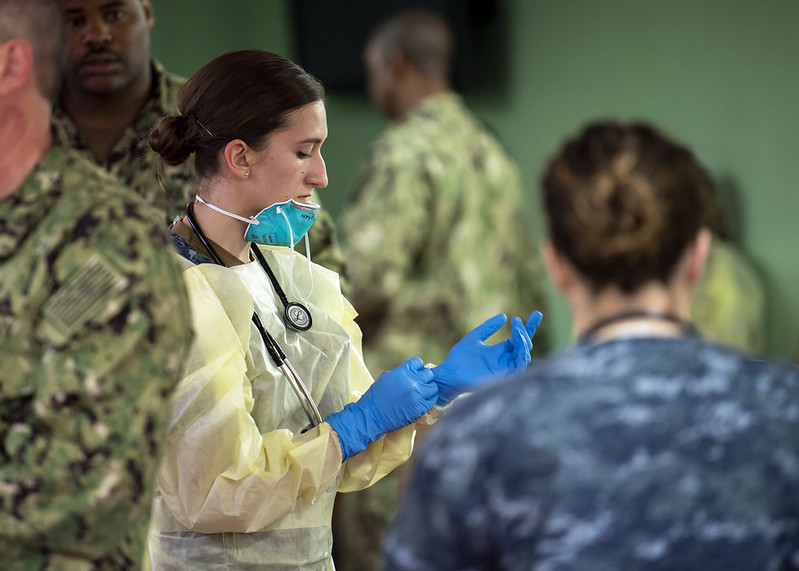This post originally appeared on the World Economic Forum. It has been republished with permission.

There are more than 1.3 million confirmed cases of COVID-19 reported worldwide as of April 6.
Continued sharp increases in infections may overwhelm health systems in any country—but especially places that are facing shortages of nurses, doctors and other frontline health providers.
The pandemic is also dealing an economic blow: People around the world are losing their jobs, as large gatherings are cancelled and people undertake social distancing, making it impossible for many businesses to continue.
Last week, it was reported that the pandemic could drive unemployment up to 20 percent—a rate not seen since the Great Depression—leaving 32 million people in the U.S. without a job. In New York, the state’s unemployment website temporarily crashed when the number of unique users rose fivefold in one day.
What if Americans who are unemployed by the pandemic could be hired to fight it?
Around the world, local residents without a medical or nursing degree have been rapidly trained, hired and equipped to respond to other epidemics that have spiraled out of control.

An epidemic anywhere can be a threat to people everywhere.
That’s true now with COVID-19—and it was true in 2014, when the Ebola virus was spreading like wildfire across Liberia and West Africa. At that time, scientists projected the virus could infect more than 1 million people—and the majority of them would die—if nothing more was done.
When Ebola threatened to bring us to our knees, community health workers did not surrender to fear. They did what they had always done: they answered the call to serve their neighbours.
Community health workers teamed up with outreach nurses to go door-to-door to prevent virus transmission through promoting hand-washing and social distancing.
They learned the signs and symptoms of Ebola and helped detect patients.
And they helped respond by encouraging Ebola patients to seek care early at hospitals.
This same community-based strategy is critical once again in our global response to COVID-19: As cases grow exponentially, so does all this work to prevent, detect and respond to the pandemic.
Healthcare teams cannot keep up. Doctors, nurses and officers in underfunded public health departments are overwhelmed by the tasks at hand.
It might be time to share these tasks with others. We could rapidly expand our healthcare teams by investing in the people closest to the problem—hiring and training the millions of people put out of work by the epidemic.
This is happening now in Liberia, where previously unemployed residents are working as community health workers to implement prevention and control measures, like organizing social distancing and hand hygiene stations. To help detect cases, nurses are making plans to work with community health workers to identify signs and symptoms of COVID-19 among their neighbours. The country is considering engaging community health workers to coordinate testing for people who may have COVID-19.
This same strategy could work in the United States, too.
Here’s what the job description of a COVID-19 community health worker might look like:
1. Prevent
- Organize and carry out social media campaigns to promote social distancing and advocate for timely policies.
- Encourage strategies in their neighbourhoods and online to promote mental and physical health and resilience.
- Deliver food and medications to the elderly, poor, immigrants and other vulnerable residents.
- Make masks at home, and donate them to supplement the stock of personal protective equipment at local hospitals.
2. Detect
- Learn the signs and symptoms of COVID-19, and help staff hotlines run by hospitals and public health departments to answer questions from the public.
- Refer possible COVID-19 patients to their nearest testing center, and organize transportation.
3. Respond
- Call people with COVID-19 who are in self-isolation with mild symptoms, and monitor them for worsening symptoms.
- Provide moral support and organize food deliveries for people with COVID-19 at home.
- With nurse supervision, monitor patients for worsening symptoms and support rapid referral of people who require hospitalization.
- With public health officers, support contact tracing, symptom reporting, and monitoring of contacts of COVID-19 patients to ensure access to testing and treatment for people who develop signs and symptoms.
- Help hospitals and non-profits raise funds for the most vulnerable.

How would they be trained?
The U.S. Centers for Disease Control and Prevention and state health departments can work with universities to develop rapid online programs to train the millions of Americans currently out of work in their own homes. Last Mile Health has launched similar online and mobile training programs globally.
There is also a proposal for a large-scale emergency programme in the U.K. to train community health workers (CHWs) to support people in their homes, initially the most vulnerable but with potential to provide a long-term model of care.
Who would hire them?
State and city health departments can request funds from federal economic relief packages and charities, and companies can support hospitals and non-profits to hire them locally.
After the COVID-19 pandemic is stopped, some of these individuals might return to jobs in their old industries. Others will find new careers in healthcare, such as home health aides or paramedics.
If done right, the value of this investment could grow with time. Countries like Liberia, Ethiopia and Malawi and states like Alaska have trained community health workers to address one epidemic, only to redeploy them in subsequent epidemics.
Today’s COVID-19 community health workers could become our epidemic response corps of the future—always ready to help us fight the next epidemic.
This story is part of the SoJo Exchange of COVID-19 stories from the Solutions Journalism Network, a nonprofit organization dedicated to rigorous reporting about responses to social problems.
The coronavirus pandemic and the response by federal, state and local authorities is fast-moving.
During this time, Ms. is keeping a focus on aspects of the crisis—especially as it impacts women and their families—often not reported by mainstream media.
If you found this article helpful, please consider supporting our independent reporting and truth-telling for as little as $5 per month.





